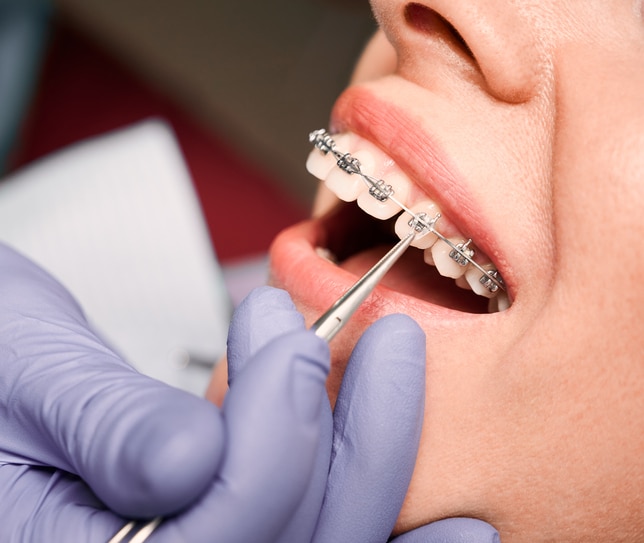Discovering the Right Cumming Orthodontist for Your Braces and Aligners Requirements
Wiki Article
Comprehensive Guide to Orthodontics Procedures for Dealing With Dental Misalignments
In the world of orthodontics, the trip to achieving a completely straightened smile entails a myriad of procedures tailored to remedy oral imbalances. From traditional braces to undetectable aligners and also medical options, the field of orthodontics provides a variety of remedies to address varying degrees of dental irregularities. Comprehending the details of each treatment, including their devices, advantages, and potential drawbacks, is essential in making notified decisions regarding one's orthodontic treatment. As we navigate with the detailed overview to orthodontic treatments for remedying dental misalignments, the detailed information of each approach will certainly unravel, clarifying the course towards a harmonious and practical dental alignment.Orthodontic Procedures Introduction

Regular adjustments and tracking are vital components of orthodontic therapy to ensure progress is on track and to make any type of required adjustments along the method. By undertaking orthodontic treatments, people can not just achieve a straighter smile but also improve their overall oral health and function.
Traditional Braces: How They Work
When thinking about orthodontic treatments for dental imbalances, traditional braces stand out as a time-tested technique for correcting teeth positioning. Typical braces consist of braces, cords, and bands that work with each other to use continuous pressure on the teeth, progressively relocating them right into the preferred placement.
One secret element of just how traditional braces job is the procedure of bone remodeling. As pressure is used to the teeth via the dental braces, the bone surrounding the teeth is reshaped to support the new tooth settings. This makeover is important for the long-lasting security of the dealt with alignment. Clients will need routine changes at the orthodontist's workplace to ensure the braces continue to apply the correct pressure for effective teeth motion.
Unseen Aligners: Disadvantages and pros
Unseen aligners supply a very discreet and practical alternative to traditional dental braces for dealing with oral misalignments. These clear, customized trays are practically unnoticeable when worn, making them an enticing alternative for individuals seeking an extra cosmetically pleasing orthodontic treatment. One of the key benefits of unnoticeable aligners is their removability, enabling easier upkeep of oral hygiene contrasted to standard braces. People can eliminate the aligners before consuming or cleaning their teeth, decreasing the risk of food obtaining stuck in the device and streamlining the cleaning process.
Surgical Orthodontic Options
Surgical interventions in orthodontics present feasible choices for attending to complicated oral imbalances that may not be efficiently fixed with traditional orthodontic treatments. While invisible aligners and traditional dental braces can deal with several orthodontic concerns, specific situations require surgical treatment to accomplish ideal results. Surgical orthodontic options are typically advised for extreme malocclusions, considerable jaw discrepancies, and cases where the underlying bone framework requires modification to achieve correct placement.One typical surgical orthodontic treatment is orthognathic surgical treatment, which includes repositioning the jaws to deal with practical issues such as trouble talking or chewing. This surgical procedure is typically carried out in cooperation with an orthodontist that aids align the teeth prior to and after the procedure. Surgical orthodontics might also entail procedures to reveal affected teeth, remove excess periodontal tissue, or improve the jawbone to create an extra harmonious face profile.
Prior to considering medical orthodontic options, people go through a thorough examination to determine the requirement and potential benefits of such treatments. cumming aligners. While surgical treatment might seem overwhelming, it can considerably boost both the function and appearances of the smile in cases where traditional orthodontic therapies fail
Retainers and Post-Treatment Care

Failure to abide with post-treatment treatment directions can result in relapse, where the teeth gradually move back towards their initial placements. Regular retainer wear, great dental hygiene, and routine dental check-ups are essential for keeping the outcomes accomplished with orthodontic surgical treatment and guaranteeing the long-term security of the dealt with dental alignment.
Conclusion
Finally, orthodontic treatments use various options for correcting oral misalignments. Traditional dental braces utilize metal braces and cords Recommended Reading to move teeth into correct positioning. Invisible aligners give an even more discreet choice however may not be ideal for all situations. Surgical orthodontic options are readily available for much more severe imbalances. Retainers are typically used post-treatment to preserve the new placement. Generally, orthodontic procedures can successfully improve oral health and wellness and visual appearance.As we navigate with the thorough guide to orthodontic treatments for remedying oral misalignments, the intricate details of each approach will unravel, losing light on the path towards a useful and harmonious oral alignment. - orthodontics
One of the most typical orthodontic therapies is the use of braces, which are composed of steel brackets and wires that apply mild stress to gradually shift teeth into the wanted position.When thinking about orthodontic therapies for dental misalignments, standard dental braces stand out as a reliable method for fixing teeth positioning. In addition, invisible aligners may not be appropriate for complicated orthodontic concerns that require look at here more considerable teeth motion, as they are commonly advised for mild to moderate cases. Retainers are tailor-made orthodontic tools designed to hold teeth in their remedied settings after the conclusion of orthodontic therapy.
Report this wiki page